
Letter from the Executive Director
Celebrating 15 Years
Has it really been fifteen years? Who would have thought! And now Monte, our first middle school intern from 1994 is graduating with a Master's Degree from UNC! We have so many students who have gone on to do so well in college and graduate school. I like to say — because it is true — that our best service is to help good kids find how they can best serve society with their abilities and skills they have learned at Shodor. Sure, we have the best materials for math and science on the Web, and the workshops we do for college faculty and pre-college teachers are second to none. But those kids! My, they have grown!
We're doing all we can to make our student offerings more accessible by going out into the community. With small grants from several small foundations, we are providing workshops in schools and community centers in Durham and Chapel Hill, besides the many workshops we offer at Shodor itself. And now those workshops are not just in the summer, either! We're partnering with area school systems to make our workshops fit the school calendars, such as spring and fall break, and to have more afterschool offerings in area schools.
At the national level, Shodor continues to lead through the National Computational Science Institute and our partner projects, including HPCUNIV.ORG, the new portal for high performance computing. As we work to ensure that Computing MATTERS, we'll be looking to extend our collaborations locally and nationally. Let us know how we can help!
Robert M. Panoff, Ph.D.
Shodor’s President & Executive Director
Shodor Wins Role in Blue Waters Project
Seeking Additional Support to Involve Triangle Youth
By Sandy Brady | Shodor Intern

Shodor’s part in the Blue Waters project was featured in the Herald Sun on April 20th, 2009 and covered in the News & Observer article featuring Dr. Panoff as Tar Heel of the Week.
Shodor was recently selected as part of a huge project called Blue Waters, which will be a big step forward for the world of computing. Shodor will have a national leadership role in teaching others to effectively harness the power of the world's largest computer, which will be ready for use in 2011.
The new machine's greater speed will allow for faster, more accurate weather predictions; more advanced modeling for medicine, materials, and industrial design; and numerous applications in many other fields. Shodor will develop an effective curriculum for teaching students from high school to graduate school, and college faculty, how to utilize this computer to solve the problems of their field.
Blue Waters, the first "sustainable petascale" supercomputer dedicated to open scientific research, is being built in partnership with the National Center for Supercomputing Applications, the University of Illinois at Champaign-Urbana, IBM and the Great Lakes Consortium for Petascale Computation. A "petascale" computer can do a million times the number of computations per second as a laptop computer, and a thousand times more computations per second than the fastest university research computers. That means that a computation that could take a laptop or a desktop three months could potentially be completed in as little as ten seconds by Blue Waters.
How does Blue Waters accomplish this feat? Through many cores. The brain of any computer is its central processing unit (CPU), and an essential part of that brain is a core, which does calculations. In the past, computers had one CPU with one core. To make computers faster and more efficient, designers have added more processors and more cores per processor. Blue Waters will have more than 100,000 CPUs, with multiple cores apiece. With the right software, these many cores can cooperate in parallel to solve big problems.
The reason Shodor needs to provide training to learners and researchers on how to leverage Blue Waters is that it is hard to break up problems into useful parallel parts that speed up science.
As an analogy, while one flower might take six weeks to grow from a seed to a blooming plant, you can't grow a flower faster by planting more seeds. There are many problems in supercomputing like this one, which even the best programmers can't speed up using a parallel computer.
Some problems, however, can be greatly accelerated if users learn methods for "parallelizing" their computer code. The Blue Waters education initiative seeks to teach more people — especially scientists and mathematicians, who can benefit the most — how to "think in parallel." While many current researchers already know how to work with supercomputers, it is extremely important to train the next generation. A deep understanding of parallel programming is more important as we move into the future. The fastest computers of fourteen years ago are the desktops of today. Shodor wants to help prepare people for even more powerful computers, so future scientists and educators can take full advantage. "The computer is only as good as the person who is using it," explains Dr. Panoff, the director of Shodor.
Dr. Thom Dunning, director of the National Center for Supercomputing Applications at the University of Illinois at Urbana-Champaign and the Blue Waters project, said, "Tomorrow's researchers have to be comfortable with petascale thinking — not just petascale computing. Shodor will help ensure that."
Shodor will integrate new lessons on supercomputing into its existing materials, helping students and educators apply power of parallel computing to their particular needs. Shodor interns will develop courses and college students will test them. Eventually, the lessons will be introduced in NCSI workshops to help college faculty understand and teach parallel computing. Along the way, Shodor hopes to generate interest, not only in computing, but also for science.
The Blue Waters project provides Shodor a $1.3 million budget to support its work with undergraduate and high school education programs, working to create a curriculum that can be taught in classrooms across the country. However, only $5,000 of that amount is available for local students' involvement.
Shodor sees this project as an exciting opportunity to involve local students in a meaningful way, but lacks the funds to hire more local students or run more workshops. Additional funds would extend Blue Waters education and work opportunities to Triangle area students through Shodor's apprenticeship and internship programs, involving many students from area high schools, colleges and universities.
Panoff said’ "I am passionate about involving students in our work. We are not just about computation and machines. We are about helping kids build their own futures."
For information on how you can support Shodor’s programs for students, email mpaisley@shodor.org or call Mary Paisley at (919) 530-1911.
Congratulations, Bob!
Tar Heel of the Week - April 5, 2009
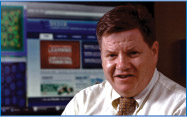
Photo Courtesy of the News & Observer
On April 5th, Dr. Robert M. Panoff, Shodor's founder and Executive Director, was honored as Tar Heel of the Week by The News & Observer and featured on page one of the Triangle & State section. Read the article here: To reinvent science education, he's enlisting all ages
Orage Quarles, III, President and Publisher of the News & Observer, wrote a letter to Bob, explaining that, by being distinguished as a Tar Heel of the Week, he is "a member of a very special group of North Carolinians who have contributed their time, skills and talents toward making North Carolina a truly great state and a wonderful place to live."
Quarles praised Bob, saying, "The contributions you have made have enhanced our State's reputation around the country."
Summer and Weekend Workshops Poster
Select a size to download:
| 100% (5100x3300) | 50% (2550x1650) |
| 33% (1683x1089) | 25% (1275x825) |

Workshop and Apprentice Activities
Photographs by Ernest Edinborough | Shodor Staff
Spring Break Workshop for Middle Schoolers
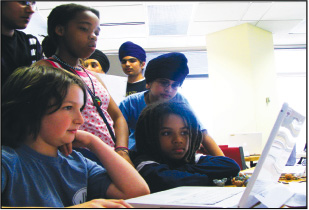
Exploring and Using HTML
Workshop students gathered around to share the websites they built in class.
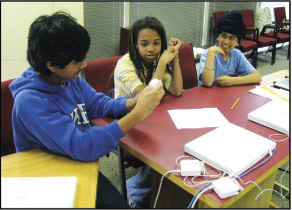
Bob's famous "How do you know?" exercise:
Students conducted non-destructive observational testing on eggs to determine whether or not they were hard-boiled.
SUCCEED Apprenticeship Program — Spring 2009
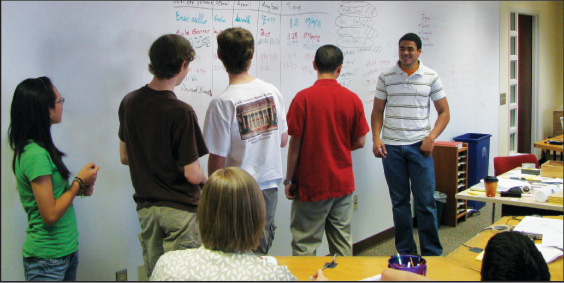
Monte Evans led a class of apprentices on Saturday, April 18th. Here, Shodor's apprentices are working on Entity Relationship ("ER") diagrams, an essential part of the database planning process.
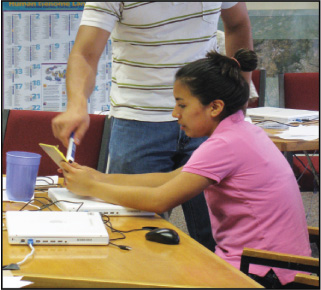
Here, Monte helps a student work through her own ideas for a database.
Shodor Scholars Program
Shodor's Apprenticeship Program (pictured above) teaches high school level students valuable 21st Century Workforce Skills including numerical modeling, graphics, professional conduct, and communication skills. The gateway experience at Shodor for most apprentices is the Shodor Scholars Program. This two-week, academically intensive program for rising 9th through 11th grades will be offered twice this summer. For more information, go to http://www.shodor.org/calendar
Interactivate News
Our most popular online mathematics
curriculum keeps getting better
By Hanley Rice | Shodor Intern
In the next few months, Shodor will be rolling out two exciting additions to Interactivate, our most popular set of interactive online mathematics tools:
- a new and improved version of the Interactivate site that already exists
- a brand new subscription-based service called InteractivatePlus
According to Shodor intern Ronnie Johnson, who has been working on the InteractivatePlus project, it will use "improved versions of Shodor’s already award-winning educational programs along with the capability to track student progress quickly and accurately."
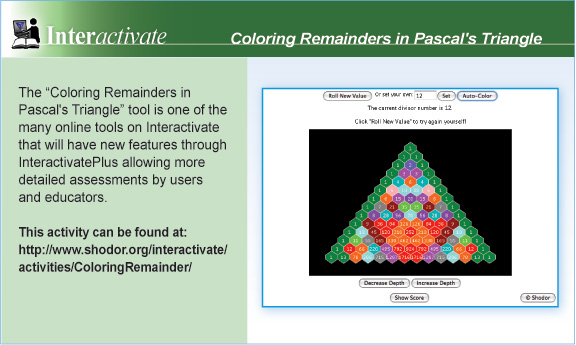
This value-added service will allow students to track their own progress while using the activities and it will allow teachers to spot weak or strong areas in their class’s knowledge.
For example, a teacher could have his or her students use the Interactivate activity Fraction Quiz as an exercise to practice operations with fractions. InteractivatePlus will record all of the students’ scores into a database. Later, the teacher can log in and examine students' scores either individually or in aggregate form. The teacher may gather statistics such as how well students worked with fractions overall, how they performed on addition and subtraction problems as compared to multiplication and division problems, whether they performed better at converting from fractions to decimals or fractions to percentages; and more.
Interactivate has more than fifty activities with built-in assessments, ranging from elementary level math to high school level Algebra.
Using InteractivatePlus to track students' progress will allow teachers more time that would otherwise have been occupied by testing and preparing for tests. "They [Teachers] will not have to take time out for tests since they will track students’ progress over time as they practice in class," explained Math Educator and Interactivate Manager Bethany Hudnutt.
Because Interactivate activities are connected to state standards, using InteractivatePlus assessments can help teachers target areas that need improvement for standardized tests.
InteractivatePlus is not just for teachers: Students and schools can subscribe, as well.
According to Hudnutt, providing teachers with InteractivatePlus will allow them more instruction time in the classroom because they can "integrate assessment components with classroom instruction."
Students will use InteractivatePlus to track their own scores and progress. Schools will be able to look at data organized in different ways including by students’ zip codes, by course, by teacher, by assessment type, and more.
Subscription pricing will vary based on the size of the subscription, but Shodor is looking for a few teachers and a school to partner with them for beta testing InteractivatePlus in the near future.
If you are a teacher or an administrator who is interested in participating, contact Bethany Hudnutt at (919) 530-1911 or bhudnutt@shodor.org.
The initial version of InteractivatePlus is scheduled to be ready by the end of August so that teachers and schools may subscribe for the 2009-2010 school year.
Sharing Innovative Ways to Teach Mathematics and the Sciences
Shodor helps educators move into the 21st Century with Interactive Computing
By Lauren Riggs | Shodor Intern
and Bethany Hudnutt | Shodor Staff
Since its inception, Shodor has created and led professional development to a variety of different audiences, settings, and formats with the purpose of integrating computing technologies into the instructional classroom. Drawing on this expertise, we work with teachers and faculty to implement the most successful strategies. Through this process, we develop highly qualified educators in the sciences and mathematics using 21st century skills and tools.
Shodor’s strength is in our ability to adapt our approach to the unique needs of the school, college or university we are working with. Our goal is to give educators the tools and technology experience to teach what they already teach ’ more effectively. We introduce free, online interactive resources that engage learners and allow them to truly understand problems by visualizing them on a computer and manipulating them to find an optimal solution.

We enjoy accommodating small groups such as the selected faculty we worked with at Bennett College for Women in Greensboro, NC. We also embrace the opportunity to reach larger groups, like the multiple cohorts of educators we worked with from a variety of middle and high schools in the eastern part of North Carolina through the TechMath program sponsored by East Carolina University in Greenville, NC.
By introducing educators around the state and nation to new ways of teaching math and science using technology, we hope to increase students’ excitement for math- and science-related careers and help them develop the skills they will need in a 21st century workforce.
At Bennett College, some Shodor staff members introduced the faculty to Maple, a math tool, and ChemBioDraw, a computational chemistry tool. Staff members then helped each of the faculty members develop their own project or application of the software to one of the courses they teach.
At East Carolina University, we toured local businesses with teachers in the TechMath program to learn about how the businesses used mathematics and technology in their everyday work. We then introduced the teachers to a few online programs with a great deal of computational muscle combining math and technology, including applications of Excel. The faculty participants could use these programs in classrooms. We then worked with these teachers to develop short modules for their classrooms, exposing their students to the math and technology as well as local businesses.
Shodor staff and interns are knowledgeable and experienced in teaching scientific, interactive computing to a wide variety of students and educators ranging from middle school students to college faculty. We work with organizations directly to suit the specific needs of that organization. We seek to develop highly qualified educators of computing technologies for teaching and learning in mathematics and the sciences.
If your organization has similar goals, contact us to see how we can work to achieve this goal together.
For more information on our programs, contact: bhudnutt@shodor.org
Monte Evans — What will he do next?
By Jamie Deal | Shodor Intern
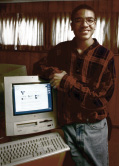
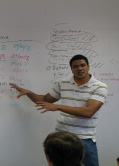
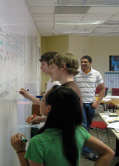 Monte as an Intern then...and Monte teaching NOW!
Monte as an Intern then...and Monte teaching NOW!
Monte Evans, Shodor’s first intern, received his Masters of Science in Information Science from the University of North Carolina at Chapel Hill this month.
After interning at Shodor through high school and college, Monte joined Shodor as staff, serving in this role for two years before starting his masters program. Since then, Monte has returned on occasion to lead workshops and inspire the next generation of Shodor kids.
In addition, he has continued his work with a successful Internet venture, VoiceThread, which he helped to create in 2005. VoiceThread ( www.voicethread.com) improves online photo/video sharing by allowing users to log comments on online albums using a microphone, a phone call, or a webcam. Users can create and listen to the resulting online discussions, or "voicethreads."
"Monte is one of those students that you expect to accomplish great things," Patricia Jacobs says.
"He is a true example of how mentoring and being exposed to (STEM) [science, math, engineering and technology] areas at an early age can influence a student to choose a career in STEM fields," she added.
Join us in congratulating him with his success and give him good wishes for his future. Congratulations, Monte! We know you will excel in whatever you do!
For more information on Monte see http://www.shodor.org/monte
Featured Online Tool
Fire: Estimating Percent
By Selene Schmittling | Shodor Intern

Improve your understanding of percentages with this "Fire: Estimating Percent" activity! Go to: http://www.shodor.org/interactivate/activities/FireEstimatingPercent/
Estimating is an essential tool. How many times have you needed to estimate whether you had enough money in your pocket to get that burger with fries or whether you had enough time for one more game of Space Raiders before you did your homework? Intelligent estimation is helpful in all math or science courses. Estimating whether or not your answer is reasonable helps not only with schoolwork but also understanding the world around you.
The Fire: Estimating Percent activity allows you to practice estimation skills by burning down a simulated forest! First you choose a probability that a tree will burn when fire reaches it. Then you click on a tree to begin burning the forest. Once the fire stops, you estimate how many trees burned either as a percentage of the forest or the actual number of trees burned. You can also choose how accurate your answer needs to be to be "correct."
Fire: Estimating Percent is a fun way to learn about percentages and practice your estimating skills. Give it try! For other activities to help sharpen your estimating skills try: Comparison Estimator, Estimator, Estimator Four, Estimator Quiz and More or Less Estimator.


